专业八语言学知识归纳
英语专八人文-最全语言学知识点

语言学* 现代语言学理论和学派1. Ferdinand de Saussure(1857-1913 瑞士):Father of modern linguistics 现代结构主义语言学创始人Course in General Linguistics《普通语言学教程》:由其学生- C. Bally & A. Sechehaye整理,现代语言学开端,19163 lines: linguistics, sociology and psychology 符号任意性理论;语言单位间的关系;语言和言语区分;共时和历时区分。
语言是符号系统。
符号是形式和意义的联合,即能指signifier和所指signified。
2. The Prague School布拉格学派:synchronic linguistics; Function1) 对语言的共时研究由于可得到全面可控的语言材料以供参考而被充分强调,同时,也没有严格理论;界限被竖立起来将之与历时语言研究相分离。
2) 强调语言的系统性这一本质属性。
3) 在某种意义上,把语言看作是一种功能,是一种有某一语言社团使用的,用来完成一系列基本职责和任务的工具。
~ Phonology and Phonological Oppositions(音位对位):Trubetzkoy–Phonetics belonged to parole whereas phonology belonged to langue. – phoneme~ Functional Sentence Perspective(FSP 句子功能前景):语言学分析理论用信息论原理来分析话语或篇章。
其基本原则就是一句话中各部分的作用取决于它对全局意义的贡献。
捷克语言学家- The point of departure is equally present to the speaker and to the hearer, which is their rallying point, the Theme.The goal of discourse presents the very information that is to be imparted to the hearer and is called the Rheme.3.The London School伦敦学派–systemic linguistics and functional linguistics Sociological approach1) J.R. Firth(1890-1960 英国):伦敦学派创始人; 学生-Malinowski & Halliday语言学的研究对象是实际使用中的语言。
专八语言学考点

专八语言学考点语言学概论一.语言的甄别特征(Design Features):语言的甄别特征(Design Features)包括:1. 任意性(Arbitrariness)2. 能产性(Productivity)3. 双层性(Duality)4. 移位性(Replacement)5. 文化传承(Cultural transmission)二.语言学的主要分支(the Main Branches of Linguistics):1. 语音学(phonetics):用以研究语音的特点,并提供语音描写、分类和标记方法的学科。
2. 音系学(phonology):研究语言中出现的区别语音及其模式是如何形成语音系统来表达意义的学科。
3. 形态学(morphology):研究词的内部结构和构词规则。
4. 句法学(syntax):用以研究词是被如何组成句子,以及支配句子构成的学科。
5. 语义学(semantics):研究语言意义的学科。
6. 语用学(pragmatics):研究语言的意义在语境中如何被理解、传递和产出的学科。
7. 宏观语言学(Macrolinguistics):主要包括社会语言学(Sociolinguistics)、心理语言学(Psycholinguistics)、人类语言学(Anthropological Linguistics)、计算机语言学(Computational Linguistics)。
三.语言学的流派(Different Approaches of Linguistics):1. 结构主义语言学(Structural Lingustics):1.1 布拉格学派(The Prague School)1.2 哥本哈根学派(The Copenhagen School)1.3 美国结构主义学派(American Structuralism)以上三个学派都受到索绪尔(Saussure)的影响,例如都区分语言和言语(Langue vs. Parole),共时和历时(Synchronic vs. Diachronic)。
专八-语言学总结

语言学Ⅰ. 语言的性质●Language is a system of arbitrary vocal symbols used for human communication.It is a means of verbal communication(言语交际).●Design FeaturesThe features that define our human languages can be called design features.⑴Arbitrariness(任意性)⑵Duality(二重性)⑶Creativity/Productivity(多产性)⑷Displacement(易境性)⑸Cultural Transmission (文化传递性)⑴Arbitrariness(任意性)The forms of linguistic signs bear no natural relationship to their meaning. e.x. pen--/pen/ book/buk/Different levels of Arbitrarinessa.Arbitrariness relationship between the sound of a morpheme(语素) and its meaning.e.x. 叮咚,轰隆English—wow wow Chinese: wangwangwangIt is only then you know the meaning that you infer that the form is appropriate.b.Arbitrariness at the syntactic levelSyntax is less arbitrary than words, and the most strictly arbitrary level of language exists in the distinctive units of sounds.c.Arbitrariness and convention (约定俗成)Arbitrariness of language makes conventionality(约定俗成性) potentially creative.⑵Duality(二重性)-- The property of having two levels of structures, such that units of the primary level are composed of elements of the secondary level and each of the two levels has its own principles of organization.the secondary unites: sounds(meaningless)the primary unites: words(have distinct and identifiable meaning)⑶Creativity/Productivity(多产性)Language is resourceful because of its duality and excursiveness(递归性—the potential to create endless sentences).⑷Displacement(易境性)-- It is means that human languages enable their users to symbolize objects, events and concepts which are nor present(in time and space) at the moment of communication.●Functions of Language⑴Informative(信息功能)⑵Interpersonal function(人际功能)—how the personal relations being established⑶Performative (行事性功能)—how language woks in real world⑷Emotive function(表情功能)—enable users to express whatever feelings they have⑸Phatic communication(寒暄功能)—the social interaction of language/ helps to define and maintain interpersonalrelations⑹Recreational function(娱乐功能)— a poetic function⑺Metalingual function(元语言功能)—language can be used to talk about languageThe lion are the unicorn all round the town.All along the town the lion ate the unicorn.The change in liner order changes our perspective about the concerns of the clause.Ⅱ. Linguistics 语言学●Linguistics is a science which takes language as its object of investigation.We must learn linguistics①systematically—beginning+engding②objectively—does according to the facts③exhaustiveness—to collect data as much as possible so as to enrich one’s knowledge andsupport one’s idea●Distinctions of Linguistics (Lyons)⑴Descriptive(描写/描述性的) vs. Prescriptive(规定性的)↖to set up roles for others to follow, designed by↑traditional grammerto talk about something according to something itself⑵Synchronic(共时研究)vs. Diachronic(历时研究)(Swiss: Saussure)Synchronic: takes a fixed instant as its point of observation.Diachronic: is the study of a language through the course of its history. (study language at least in two periods of time) Comparison: Synchronic: what a language is in a period of timeDiachronic: find our the changes from one language to another language⑶Langue(语言) & Parole(言语)(Saussure)Langue: the linguistic competence of the speaker (the abstract system of language)Parole: the actual phenomena or data of linguistics (the actual use of language)Langue govern parole; parole reacts langue⑷Competence(语言能力) & Performance(语言运用)( American: Chomsky)↑↖the linguistic knowledge in the ideal speakers’ mindthe ability of native/ideal speaker of language⑸Etic(非位的) vs. Emic(位学的)(American: Pike)↑↖Phonemics(音位学的),abstract units of languagephonetics(语音学的),something concreateⅢ. Phonetics 语音学●Phonetics study speech sounds, including the production of speech(how speech sounds are actually made, transmitted andreceived), the sounds of speech, the description and classification of speech sounds, words and connected speech.●Consonant: these is an obstruction of the air stream at some point of the vocal tract.V owel: these is no obstruction of the air stream at some point of the vocal tract.Ⅳ. Phonology 音位学●Phonology is the study of sound systems—the invention of distinctive speech sounds that occur in a language and thepatterns wherein they fall.广义的音位学指对自然语言声音系统的一般特种的研究,包括语音学。
专八人文知识--语言学
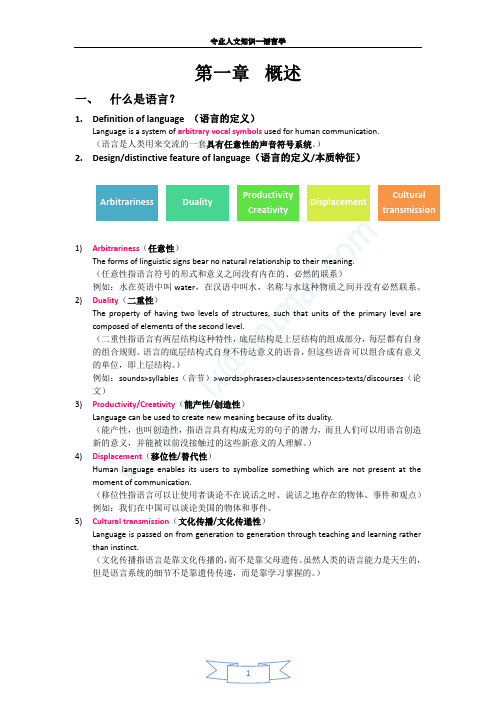
第一章概述一、什么是语言?1.Definition of language (语言的定义)Language is a system of arbitrary vocal symbols used for human communication.(语言是人类用来交流的一套具有任意性的声音符号系统。
)2.Design/distinctive feature of language(语言的定义/本质特征)1)2)3)4)(移位性指语言可以让使用者谈论不在说话之时、说话之地存在的物体、事件和观点)例如:我们在中国可以谈论美国的物体和事件。
5)Cultural transmission(文化传播/文化传递性)Language is passed on from generation to generation through teaching and learning rather than instinct.(文化传播指语言是靠文化传播的,而不是靠父母遗传。
虽然人类的语言能力是天生的,但是语言系统的细节不是靠遗传传递,而是靠学习掌握的。
)二、什么是语言学?Linguistics is a scientific study of language.(语言学是对语言的科学研究)语言学的研究对象不是某特定的语种,而是人类所有的语言,在考察分析大量语言现象的基础上总结语言规律。
语言学家想要回答的基本问题是:什么是语言?语言的机制是什么?人们是如何使用语言实现各种目的的。
三、语言学的重要概念1.descriptive vs. prescriptive(描述性与规定性)描述性研究是现代语言学家采取的基本立场,注重观察分析语言中的事实,目的通常是描述人们一般是怎么说话、写作的。
规定性研究注意总结语言中的标准,目的通常是规定人们应该如何说话、写作。
例如:规定只能用单数、复数2.synchronic vs. diachronic(共时性与历时性)synchronic: the study of a language through the course of its history(共时研究以某个特定时期的语言为研究对象)例如:莎士比亚时代语言研究diachronic: takes a fixed instant as its point of observation(历时研究则研究语言各个阶段的发展变化,研究语言的历史发展规律)ngue vs. parole(语言与言语)该区分是现代语言学鼻祖Saussure提出的。
英语专业八级语言学总结+(2)

I. Introduction1. What is LanguageLanguage is a system of arbitrary vocal symbols used for human communication.2. What is Linguistics(语言学)Linguistics is the scientific study of language.3.Some Basic Distinctions(区分) in Linguistics3.1 Speech and WritingOne general principle(原则) of linguistic analysis is the primacy of speech over writing. Writing gives language new scope(范畴) and uses that speech does not have.3.2 Descriptive(描述性) or Prescriptive(说明性)A linguistic study is descriptive if it describes and analyses facts observed; it is prescriptive if it tries to lay down rules for "correct" behavior.3.3 Synchronic(共时) and Diachronic(历时) StudiesThe description of a language at some point in time is a synchronic study and T he description of a language as it changes through time is a diachronic study.3.4 Langue(语言) and Parole(言语)This is a distinction made by the Swiss linguist F.De Saussure (索绪尔)early last century. langue refers to the abstract linguistic system shared by a ll the members of a speech community and parole refers to the actualized(实际的) language, or realization of langue.3.5 Competence(能力)and Performance(行为)Competence is the ideal language user's knowledge of the rules of his language.Performance is the actual realization of this knowledge in utterances(发声).4.The Scope of LinguisticsGeneral linguistics is the study of language as a whole.Phonetics(语音学) is the branch of linguistics which studies the characteristics of speech so unds and provides methods for their description, classification and transcripti on.Phonology(音韵学) is the branch of linguistics which studies the sound patterns of languages.Morphology(词法) is the branch of linguistics which studies the form of words.Syntax(句法) is the branch of linguistics which studies the rules governing the combinat ion of words into sentences.Semantics(语义学) is the branch of linguistics which studies the meaning of language.Applied linguistics(应用语言学) is the study of the teaching of foreign and second languages.Sociolinguistics is the study of the relationship between language and society.Psycholinguistics is the study of the relationship between language and the min d.Historical Linguistics(历史语言学) is the study of language changes.Anthropological linguistics(人文语言学) uses the theories and methods of anthropology to study language variation a nd language use in relation to the cultural patterns and beliefs of man.Neurolinguistics(神经语言学) studies the neurological basis of language development and use in human bei ngs.Mathematical linguistics(数学语言学) studies the mathematical features of language, often employing models and c oncepts of mathematics.Computational linguistics(计算语言学) is an approach to linguistics in which mathematical techniques and concepts (概念) are applied, often with the aid of a computer.II. Phonetics(语音学)1. scope of phoneticsSpeech sounds may be studied from different angles, thus we have at least three branches of phonetics:Articulatory phonetics(发音语音学)we may examine the way in which a speech sound is produced to discover which vo cal organs are involved and how they coordinate(协调) in the process.Auditory phonetics (听觉语音学)we may look into the impression a speaker makes on the hearer as mediated(调节) by the ear, the auditory nerve(神经) and the brain.Acoustic phonetics (声学语音学) we study the physical properties of speech sounds, as transmitted(传送) between mouth and ear.2. The vocal organsThe vocal organs may be viewed as consisting of three parts, the initiator of t he air-stream,(气流发生器官) the producer of voice(声音发生器官) and the resonating cavities.(声音共振器官)3. Consonants(辅音)Places of articulation(发音部位): bilabial,(双唇) Labiodentals,(唇齿) dental,(齿) alveolar,(齿龈) retroflex,(卷舌) palate-alveolar,(上齿龈) palatal,(上颚) velar,(软腭) uvular,(小舌) glottal(声门)Manners of articulation: plosive,(暴破) nasal,(鼻音) trill,(颤音) lateral,(边音) fricative,(摩擦) approximant,(近似音) affricate(破擦)4. Vowels (元音)The classification of vowels: the height of tongue raising (high, mid, low), th e position of the highest part of the tongue(front, central, back), and the deg ree of lip rounding(rounded, unrounded)III. Phonology(音韵学)回目录1. phonemes(音素):a distinctive(有区别的) sound in a language.2. Allophones(音位变体):The nondistinctive sounds are members of the same phoneme.3. Minimal pairs(最小对立体): word forms which differ from each other only by one sound.4. Free variation (自由变异):If two sounds occurring in the same environment(环境), they does not produce a different word form, but merely a different pronu nciation of the same word.5. Complementary distribution(互补分布):Not all the speech sounds occur in the same environment. When two sounds never occur in the same environment6.Suprasegmental phonology(超音段音位):the study of phonological properties(性质) of units lager than the segment-phoneme. They are syllable(音节), stress,(重音) word stress, sentence stress. pitch (音调)and intonation(语调). IV. Morphology(词法)回目录1. inflection(构形法):the grammatical relationships through the addition of inflectional affixes.(屈折词缀)2. Word-formation(构词):the processes(过程) of word variations signaling lexical relationships.(表明词法关系) They are compound(合成)and derivation (派生).3. Morpheme(词素): the smallest unit in terms of relationship between expression and content.4. Allomorph(同质异象变体): some morphemes have considerable variation, for instance, alternate shap es or phonetic forms.5. Types of morphemes: They are roots,(词根) affix(词缀) and stem(词干).6. Lexicon(语言词汇):in its most general sense, is synonymous with vocabulary.7. Closed-class words(封闭性) and open-class words(开放性):the former whose membership is fixed or limited and the latter whose membership is in principle(实际上) indefinite or unlimited.8. Word class(词性):It displays a wider range of more precisely defined classes.9. Lexeme(词位):the smallest unit in the meaning system of a language that can be distinguished from other smaller units.10. Idiom(习语,成语):Most phrasal lexemes are idioms. It is especially true for a sequence of words(词序) which is semantically(语义上) and often syntactically(句法上) restricted.(限制)11. Collocation(搭配): the habitual(习惯的) co-occurrences (同时出现)of individual lexical items.V. Syntax (句法)回目录1. Positional relation or word order(词序):the sequential(顺序) arrangement of words in a language.2. Construction or constituent (句子结构): the overall process of internal (内部)organization of a grammatical unit .3. Syntactic function(句法功能): the relationship between a linguistic form and other parts of the lingui stic pattern in which it is used. The names of functions are expressed in terms of subjects, objects, predicates, modifiers,(修饰语) complements(补语), etc.4. Category(范畴):It refers to classes and functions in its narrow sense, e.g. noun, verb, subjec t, predicate, noun phrase, verb phrase, etc. The categories of the noun include number, gender, case and countability.5. Phrase: a single element of structure containing more than one word, and lac king the subject-predicate structure typical of clause.6. Clause: a group of words with its own subject and predicate, if it is includ ed in a larger sentence.7. Sentence: It is the minimum part of language that expresses a complete thoug ht.VI. Semantics(语义)回目录1. Conceptualism or mentalism (概念主义):Following F. De Saussure(索学尔)'s "sign" theory, the linguistic sign is said to consist of a signifier (所指)and signified(被指), i.e., a sound image and a concept, liked by a psychological(心理的) "associative" bond.(相关联系)2. Mechanism(机械主义):Some linguists, Bloomfield,(布鲁费尔德) for example, turned to science to counter(反)-act the precious theories and this leads to what call the mechanistic approach (方法). The nature of this theory has nothing to do with the scientific study of mental phenomena.(智力现象)3. Contextualism (语境主义):It is based on the presumption(假定) that one can derive meaning from or reduce it to observable context.4. Behaviorism (行为主义):Behaviourists attempt to define (定义)the meaning of a language form as "the situation(情景) in which the speaker utters(说话) it and the response(反应) it calls forth in the hearer."5. functionalism (功能主义):functionalists as represented (代表)by the Prague school(布拉格学派) linguists and neo-Firthian (新弗斯)linguists, approach the problem from an entirely new orientation(方法). They argue(争辩) that meaning could only be interpreted(解释) from its use or function in social life.6. Sense relationships: While reference deals with the relationship between the linguistic elements, words, sentences, etc.,and the non-linguistic world of ex perience, sense relates to the complex system of relationships that hold betwee n the linguistic elements themselves. They include synonymy(同义词),antonymy(反义词),hyponymy(下层次)Polysemy(一词多义)and Homonymy (同音异义词)7. Semantic analysis: It includes 1) componential(成分) analysis which defines the meaning of a lexical element in terms of semant ic components.(意义成分)2) predication (表述)analysis in which the meaning of a sentence is not merely the sum of the meanin gs of the words which compose it. 3) relational components in which the semanti c analysis of some words presents a complicated picture, because they show rela tions between two and perhaps more terms.VII. Language variation (语言变化)回目录1. Lexical change(词汇的变化):changes in lexis.2. Invention: (新造词)new entities.3. Compounding 合成词)New words are sometimes constructed by combining two old words.4. Blending: (混合词):It is a relatively complex form of compounding, in which two roots are blended by joining the initial part of the first root and the final part of the second root, or by joining the initial parts of the two roots.5. Abbreviation or clipping (缩写)A new word is created by cutting the final part or cutting the initial part.6. acronym 取首字母的缩写词)It is made up from the first letters of the name of an organization, which has a heavily modified (修饰) headword.7. metanalysis (再分化)It refers to a process through which a division is made where there were note b efore.8. Back-formation (逆构词) It refers to an abnormal(非正常) type of word-formation where a shorter word is derived by deleting(去掉) an imagined affix from a longer form already present in the language.9. Analogical creation:(类比造词)It can account for(说明) the co-existence of two forms, regular and irregular, in the conjugation(结合) of some English verbs.10. Borrowing(借用):English in its development has managed to widen her vocabulary by borrowing wor ds from other languages.11. Phonological change(音变):It is related to language variation in the phonological system of language. It includes loss,(省音) addition,(加音) assimilation,(同化)dissimilation.(异化)12. Grammatical change: Changes in both morphology(词法) and syntax(句法) are listed under this heading.13. Semantic change:(语义变化)It includes broadening,(语义扩大) narrowing,(语义缩小) meaning shift,(意义转化) class shift(词性转换) and folk etymology.(词源变化)14. Orthographic change :(正字法)Changes can also be found at the graphetic level.。
英语专八人文知识之语言学(详细简化版)

专八加油↖(^ω^)↗语言学(缩略版)1 语言的四个特征:任意性(Arbitrariness),二重性(Duality),创造性(Creativity),移位性(Displacement)2 语言的七个功能:信息功能(Informative),人际功能(Interpersonal Function),施为功能(Performative),感情功能(Emotive Function),寒暄功能(Phatic Communion),娱乐功能(Recreation Function)元语言功能(Metalingual Function)3 语言学的主要分支:语音学(Phonetics),音系学(Phonology)形态学(Morphology),句法学(Syntax),语义学(Semantics),语用学(Pragmatics),4 宏观语言学(Macrolinguistics)的分支:心理语言学(Psycholinguistics),社会语言学(Sociolinguistics),人类语言学(Anthropological Linguistics,计算机语言学(Computational linguistics)5 规定式(Prescriptive)---描述事情应该是怎样的(describe how things ought to be)描写式(Descriptive)---描述事情本是怎样的(describe how thing are)6 共时研究(Synchronic)---以某个特定时期的语言为研究对象(takes a fixed instant as its point of observation)历时研究(Diachronic)---研究语言各个阶段的发展变化(Study of a language through the course of its history)7 语言(Langue)---说话者的语言能力(the linguistic competence of the speaker)言语(Parole)---语言的实际现象或语料(the actual phenomena or data of linguistic)----索绪尔(Saussure)区分8 语言能力(Competence)---理想语言使用者关于语言的知识储备(underlying knowledge)语言运用(Performance)---真实的语言使用者在实际场景中语言的使用(Actual use ofLanguage)----乔姆斯基(Chomsk)区分9 语音学主要分支:发音语言学(Articulatory Phonetics),声学语言学(Acoustic Phonetics)。
专八语言学考点

语言学概论一.语言的甄别特征(Design Features):语言的甄别特征(Design Features)包括:1. 任意性(Arbitrariness)2. 能产性(Productivity)3. 双层性(Duality)4. 移位性(Replacement)5. 文化传承(Cultural transmission)二.语言学的主要分支(the Main Branches of Linguistics):1. 语音学(phonetics):用以研究语音的特点,并提供语音描写、分类和标记方法的学科。
2. 音系学(phonology):研究语言中出现的区别语音及其模式是如何形成语音系统来表达意义的学科。
3. 形态学(morphology):研究词的内部结构和构词规则。
4. 句法学(syntax):用以研究词是被如何组成句子,以及支配句子构成的学科。
5. 语义学(semantics):研究语言意义的学科。
6. 语用学(pragmatics):研究语言的意义在语境中如何被理解、传递和产出的学科。
7. 宏观语言学(Macrolinguistics):主要包括社会语言学(Sociolinguistics)、心理语言学(Psycholinguistics)、人类语言学(Anthropological Linguistics)、计算机语言学(Computational Linguistics)。
三.语言学的流派(Different Approaches of Linguistics):1. 结构主义语言学(Structural Lingustics):1.1 布拉格学派(The Prague School)1.2 哥本哈根学派(The Copenhagen School)1.3 美国结构主义学派(American Structuralism)以上三个学派都受到索绪尔(Saussure)的影响,例如都区分语言和言语(Langue vs. Parole),共时和历时(Synchronic vs. Diachronic)。
英语专八人文常识 语言学

词义演变(Semantic Change)
1. widening of meaning/generalization(词义扩大) 2. narrowing of meaning/specialization(词义缩小) 3. meaning shift(词义转移):
degradation(词义降格)
creativity(多产性)
displacement(移位性) interchangibility(可交替性)
cultural transmission(文化传输性)
2. prescriptive and descriptive(规定性和描述性研究) synchronic and diachronic(共时与历时研究) 3. competence and performance(语言能力与应用) 4. langue and parole (语言与言语)
语义学(Semantics)
2. semantic triangle(语义三角)
3. synonymy(同义关系) 4. antonymy(反义关系) 5. hyponymy(上下义关系) 6. polysemy(一词多义) 7. homonymy(同形/同音异义关系)
1. Leech’s seven types of meaning(利奇的七种意义)
1. Context(语境) 2. Speech Act Theory(言语行为理论): a) John Austin: Locutionary act(言内行为) Illocutionary act(言外行为) Perlocutionary act(言后行为) indirect speech act b) John Searle: representatives(阐述类) directives(指令类) commissives (承诺类) expressives(表达类) declarations(宣一、对知名的语言学家及其基本理论的重点考查
专八语言学知识要点

第三章英语语言学第一节语言学基本概念知识点较多,但是多集中于基本概念和运用,不需要深入挖掘,记住基本概念即可。
1 语言的特点和功能特点:Creativity 可创造性Duality 两重性(声音和意义)Arbitrariness 任意性Displacement 移位性Cultural Transmission 文化传递性Interchangeabilty 可交换性Reflexivity 自反性人类的语言可以描述语言本身功能:Informative 信息功能(功能语言学中称之为ideational function)Interpersonal 人际功能通过语言来建立社会联系Performative 施为功能通过语言来完成任务,来自于语用学Emotive 感情功能可以改变听者的感情Phatic Communion 交感功能特定的表达方式来维护关系,例如打招呼Recreational 娱乐功能,例如唱歌Metalingual 元语言功能可以用语言来谈论语言本身2 语言学的主要分支内部分支:Phonetics 语音学Articulatory Phonetics 发音语音学语音产生Acoustic Phonetics 声学语音学研究物理特性Auditory Phonetics 听觉语音学发音的潜在机制Consonants / VowelsPhonology 音系学研究语音和音节结构分布和排列Phone 音素语言的一个单元或是音段Phoneme 音位在语言中具有区别意义的最小的语言单位Allophones 音位变体put spanContrastive Distribution 对立分析能够找到的最小的语音对bear pearComplementary Distribution 互补分析从不在相同环境出现的音位变体peak speakFree Variation 自由变体同一个词由于某个原因发了两个音,这种差异可能来源于方言或是习惯increaseSuprasegemental Features 超音段特征(音节、重音、音调、语调)Morphology 形态学研究英语中最小单位——语素和成词过程,即单词的内部构造Morpheme 词素最小的有意义的语言单位Free Morpheme 自由语素(有自己构成英语单词的称为此,是单词root/stem)和BoundMorpheme 粘连语素(需要和自由语素联合构成单词的称为此,是词缀,进一步分为Inflectional Affixes 屈折词缀,在现代英语中主要指单复数,时态比较级等等和Derivational Affixes 派生词缀,这是形成新词的关键)。
专八考试知识语言学部分
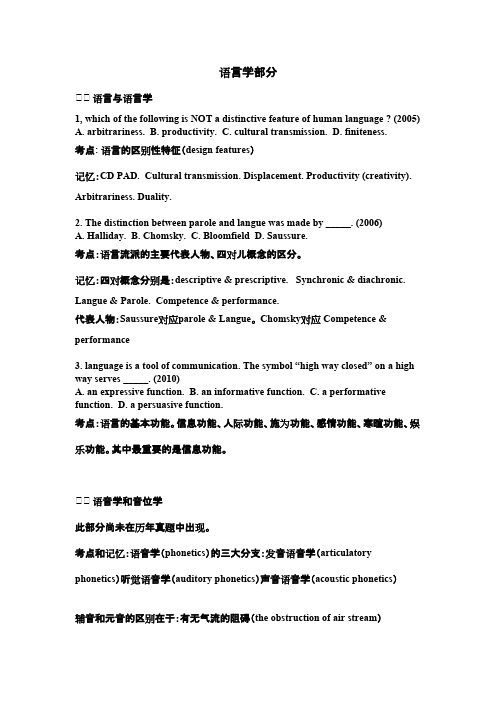
语素可以分为自由语素free morpheme 和粘着语素bound morpheme. 自由语素可以单独出现或单独构成词语,比如 pleasant, cell. 粘着语素必须与其他语素一起出现,不能独立成词,比如 dis- ex- con-
上下义:例如animal-the pole bear, kangaroo, crocodile。其中animal是上义词super ordinate, 剩下的词叫下义词 hyponyms.
句子之间的语义关系semantic relations between sentences 有以下几种:1、蕴含entailment 例如:A.他去了中国。B.他去了亚洲。A蕴含于B。A entails B. 判断方法:A真B真,B假A假,A假B不一定,B真A不一定。 2.、预设 presupposition 例如:A.我的自行车需要修理。B.我有自行车。A预设于B。A presupposes B. 判断方法:其中的一个句子以另一个为前提条件。A真B真,A假B还真。
is called ______. (2008) A. hyponymy. B. synonymy. C. polysemy. D. homonymy. 考点:考察词汇之间的涵义关系sense relations.
记忆:涵义关系有5个:同义关系synonymy, 反义关系antonymy, 一词多义
①① 语用学 1. The speech act theory was first put forward by ______. (2005) 2. What essentially distinguishes semantics and pragmatics is the notion of
英语专八语言学知识复习资料汇编
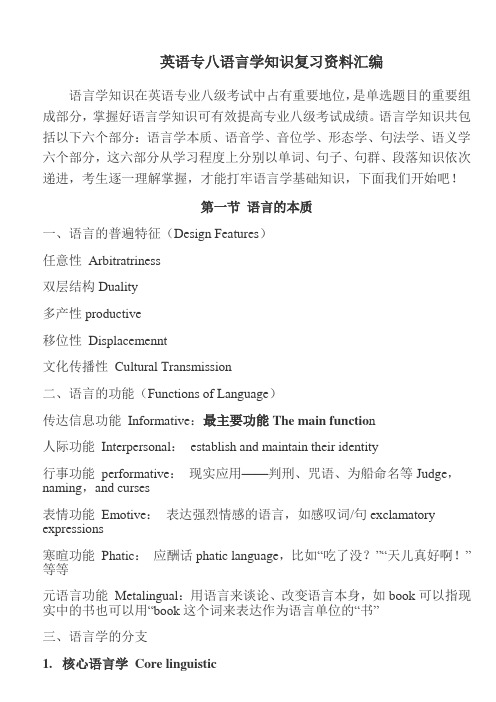
英语专八语言学知识复习资料汇编语言学知识在英语专业八级考试中占有重要地位,是单选题目的重要组成部分,掌握好语言学知识可有效提高专业八级考试成绩。
语言学知识共包括以下六个部分:语言学本质、语音学、音位学、形态学、句法学、语义学六个部分,这六部分从学习程度上分别以单词、句子、句群、段落知识依次递进,考生逐一理解掌握,才能打牢语言学基础知识,下面我们开始吧!第一节语言的本质一、语言的普遍特征(Design Features)任意性Arbitratriness双层结构Duality多产性productive移位性Displacemennt文化传播性Cultural Transmission二、语言的功能(Functions of Language)传达信息功能Informative:最主要功能The main functio n人际功能Interpersonal:establish and maintain their identity行事功能performative:现实应用——判刑、咒语、为船命名等Judge,naming,and curses表情功能Emotive:表达强烈情感的语言,如感叹词/句exclamatory expressions寒暄功能Phatic:应酬话phatic language,比如“吃了没?”“天儿真好啊!” 等等元语言功能Metalingual:用语言来谈论、改变语言本身,如book可以指现实中的书也可以用“book这个词来表达作为语言单位的“书”三、语言学的分支1. 核心语言学Core linguistic语音学Phonetics音位学Phonology形态学Morphology句法学Syntax.语义学Semantics语用学Pragmatics2. 边缘语言学Peripheral:·心理语言学psycho-linguistics·社会语言学socio-linguistics·人类语言学anthropo-linguistics·计算机语言学computer-linguistics四、语言学中几对基本概念1. 规定性研究Prescriptive与描述性研究DescriptivePrescriptive:着重于语言中“标准Standards”认为语言中存在着一种地位最高的语言形态,如标准语法/语音等,为规定人们如何说话、写作Descriptive:着重于语言中“事实Facts”,目的是描述人们一般是怎样说话、写作的2. 共时研究Synchronic和历时研究Diachronic3.语言Langue和言语Parole(由Ferdinand de Saussure索绪尔提出)Langue:指语言系统的整体the whole linguistic system,所有语言使用个体头脑中存储的word-image的总和,这个整体相对比较稳定。
英语专业八级语言学总结(中)

一、语言和语言学1、语言的区别性特征:Design of features of language任意性 arbitrariness 指语言符号和它代表的意义没有天然的联系二重性 duality 指语言由两层结构组成创造性 creativity 指语言可以被创造移位性 displacement 指语言可以代表时间和空间上不可及的物体、时间、观点2、语言的功能(不是很重要)信息功能 informative人际功能 interpersonal施为功能 performative感情功能 emotive function寒暄功能 phatic communication娱乐功能 recreational function元语言功能 metalingual function3、语言学主要分支语音学 phonetics 研究语音的产生、传播、接受过程,考查人类语言中的声音音位学 phonology 研究语音和音节结构、分布和序列形态学 morphology 研究词的内部结构和构词规则句法学 syntax 研究句子结构,词、短语组合的规则语义学 semantics 不仅关心字词作为词汇的意义,还有语言中词之上和之下的意义。
如语素和句子的意义语用学 pragmatics 在语境中研究意义4、宏观语言学 macrolingustics心理语言学 psycholinguistics社会语言学 sociolinguistics人类语言学 anthropological linguistics计算机语言学 computational linguistics5语言学中的重要区别规定式和描写式:规定式:prescriptive说明事情应该是怎么样的描写式:descriptive 说明事情本来是怎么样的共时研究和历时研究:共时:synchronic 研究某个特定时期语言历时:diachronic 研究语言发展规律语言和言语:语言:langue指语言系统的整体言语:parole指具体实际运用的语言语言能力和语言运用:乔姆斯基(chomsky提出)能力:competence用语言的人的语言知识储备运用:performance 真实的语言使用者在实际中的语言使用二、语音学1、语音学分支发音语音学articulatory phonetics研究语言的产生声学语言学acoustic phonetics 研究语音的物理属性听觉语音学 auditory phonetics 研究语言怎样被感知2 IPA(国际音标)是由daniel Jones琼斯提出的三、音位学1、最小对立体minimal pairs2、音位 phoneme3 音位变体 allophones4 互补分布 complementary distribution5 自由变体 free variation6 区别特征 distinctive features7 超音段特征 suprasegmental feature音节 syllable 重音stress 语调tone 声调intonation四形态学1 词的构成语素morpheme自由语素free morpheme粘着语素bound morpheme词根 Root词缀affix词干stem屈折词汇和派生词汇 inflectional affix and derivational affix 2 特有的词汇变化lexical change proper新创词语invention混拼词blending缩写词abbreviation首字母缩写词 acronym逆构词汇back-formation例:editor—edit类推构词analogiacal creation 例:work-worked,,slay-slayed 外来词 borrowing五句法学1 范畴category 数number 性gender 格case 时tense 体aspect一致关系concord 支配关系govenrment2 结构主义学派the structure approach组合关系 syntagmatic relation词和词组合在一起聚合关系 paradigmatic 具有共同的语法作用的词聚在一起结构和成分 construction and constituents :句子不仅是线性结构liner structure还是层级结构hierarchical structure (句子或短语被称为结构体,而构成句子或短语即结构体的称为成分)3 直接成分分析法 immediate constitutional analysis指把句子分成直接成分-短语,再把这些短语依次切分,得到下一集直接成分,这样层层切分,直到不能再分4 向心结构和离心结构endocentric and exocentric constructions向心:指一个结构中有中心词,例an old man ,中心为man离心:指结构中没有明显的中心词。
专八语言学知识汇总

全面的语言学知识一、语言和语言学1、语言的区别性特征:Design of features of language任意性arbitrariness 指语言符号和它代表的意义没有天然的联系二重性duality 指语言由两层结构组成创造性creativity 指语言可以被创造移位性displacement 指语言可以代表时间和空间上不可及的物体、时间、观点2、语言的功能(不是很重要)信息功能informative人际功能interpersonal施为功能performative感情功能emotive function寒暄功能phatic communication娱乐功能recreational function元语言功能metalingual function3、语言学主要分支语音学phonetics 研究语音的产生、传播、接受过程,考查人类语言中的声音音位学phonology 研究语音和音节结构、分布和序列形态学morphology 研究词的内部结构和构词规则句法学syntax 研究句子结构,词、短语组合的规则语义学semantics 不仅关心字词作为词汇的意义,还有语言中词之上和之下的意义。
如语素和句子的意义语用学pragmatics 在语境中研究意义4、宏观语言学macrolingustics心理语言学psycholinguistics 社会语言学sociolinguistics 人类语言学anthro pological linguistics 计算机语言学computational linguistics5 语言学中的重要区别规定式和描写式:规定式:prescriptive说明事情应该是怎么样的描写式:descriptive 说明事情本来是怎么样的共时研究和历时研究:共时:synchronic 研究某个特定时期语言历时:diachronic 研究语言发展规律语言和言语:语言:langue指语言系统的整体言语:parole指具体实际运用的语言语言能力和语言运用:乔姆斯基(chomsky提出)能力:competence用语言的人的语言知识储备运用:performance 真实的语言使用者在实际中的语言使用二、语音学1、语音学分支发音语音学articulatory phonetics研究语言的产生声学语言学acoustic phonetics 研究语音的物理属性听觉语音学auditory phonetics 研究语言怎样被感知2 IPA(国际音标)是由daniel Jones琼斯提出的三、音位学1、最小对立体minimal pairs2、音位phoneme3 音位变体allophones4 互补分布complementary distribution5 自由变体free variation6 区别特征distinctive features7 超音段特征suprasegmental feature音节syllable 重音stress 语调tone 声调intonation四形态学1 词的构成语素morpheme 自由语素free morpheme 粘着语素bound morphemeRoot 词根词缀affix 词干stem屈折词汇和派生词汇inflectional affix and derivational affix2 特有的词汇变化lexical change proper新创词语invention 混拼词blending 缩写词abbreviation首字母缩写词acronym 逆构词汇back-formation例:editor—edit类推构词analogiacal creation 例:work-worked,,slay-slayed外来词borrowing五句法学1 范畴category 数number 性gender 格case 时tense 体aspect一致关系concord 支配关系govenrment2 结构主义学派the structure approach组合关系syntagmatic relation词和词组合在一起聚合关系paradigmatic 具有共同的语法作用的词聚在一起结构和成分construction and constituents :句子不仅是线性结构liner structure 还是层级结构hierarchical structure (句子或短语被称为结构体,而构成句子或短语即结构体的称为成分)3 直接成分分析法immediate constitutional analysis指把句子分成直接成分-短语,再把这些短语依次切分,得到下一集直接成分,这样层层切分,直到不能再分4向心结构和离心结构endocentric and exocentric constructions向心:指一个结构中有中心词,例an old man ,中心为man离心:指结构中没有明显的中心词。
英语专八人文知识之语言学部分

复习专八的同志们注意啦,个人潜心整理--人文知识之语言学部分,希望能帮上点儿忙,一起加油!作者:張旭BEYONDTEM-8 语言学知识复习总结重要概念梳理CNU 张旭ZX第一节语言的本质一、语言的普遍特征(Design Features)1任意性Arbitratriness:shu 和Tree都能表示“树”这一概念;同样的声音,各国不同的表达方式2双层结构Duality:语言由声音结构和意义结构组成(the structure of sounds and meaning)3多产性productive:语言可以理解并创造无限数量的新句子,是由双层结构造成的结果(Understand and create unlimited number with sentences)4移位性Displacemennt:可以表达许多不在场的东西,如过去的经历、将来可能发生的事情,或者表达根本不存在的东西等5文化传播性Cultural Transmission:语言需要后天在特定文化环境中掌握二、语言的功能(Functions of Language)6 1. 传达信息功能Informative:最主要功能The main function7 2. 人际功能Interpersonal:人类在社会中建立并维持各自地位的功能establish and maintain their identity8 3. 行事功能performative:现实应用——判刑、咒语、为船命名等Judge,naming,and curses9 4. 表情功能Emotive:表达强烈情感的语言,如感叹词/句exclamatoryexpressions10 5. 寒暄功能Phatic:应酬话phatic language,比如“吃了没?”“天儿真好啊!”等等11 6. 元语言功能Metalingual:用语言来谈论、改变语言本身,如book可以指现实中的书也可以用“book这个词来表达作为语言单位的“书”三、语言学的分支1. 核心语言学Core linguisticl 语音学Phonetics:关注语音的产生、传播和接受过程,着重考察人类语言中的单音。
专八考试知识语言学部分

语言学部分一、语言与语言学1, which of the following is NOT a distinctive feature of human language ? (2005) A. arbitrariness. B. productivity. C. cultural transmission. D. finiteness.考点: 语言的区别性特征(design features)记忆:CD PAD. Cultural transmission. Displacement. Productivity (creativity). Arbitrariness. Duality.2. The distinction between parole and langue was made by _____. (2006)A. Halliday.B. Chomsky.C. BloomfieldD. Saussure.考点:语言流派的主要代表人物、四对儿概念的区分。
记忆:四对概念分别是:descriptive & prescriptive. Synchronic & diachronic. Langue & Parole. Competence & performance.代表人物:Saussure对应parole & Langue。
Chomsky对应Competence & performance3. language is a tool of communication. The symbol “high way closed” on a high way serves _____. (2010)A. an expressive function.B. an informative function.C. a performative function.D. a persuasive function.考点:语言的基本功能。
语言学知识(专八)

语言学知识语言学是对语言的系统研究,对于一个学习英语的人来说,应该懂一点语言学的知识,它可以在理论上对学习语言有指导作用,有助于更好的学习语言,下面介绍一点语言学知识。
I. Introduction1. What is LanguageLanguage is a system of arbitrary vocal symbols used for human communication.2. What is Linguistics(语言学)Linguistics is the scientific study of language.3.Some Basic Distinctions(区分) in Linguistics3.1 Speech and WritingOne general principle(原则) of linguistic analysis is the primacy of speech over writing. Writing gives language new scope(范畴) and uses that speech does not have.3.2 Descriptive(描述性) or Prescriptive(说明性)A linguistic study is descriptive if it describes and analyses facts observed; it is prescriptive if it tries to lay down rules for "correct" behavior.3.3 Synchronic(共时) and Diachronic(历时) StudiesThe description of a language at some point in time is a synchronic study and The description of a language as it changes through time is a diachronic study.3.4 Langue(语言) and Parole(言语)This is a distinction made by the Swiss linguist F.De Saussure (索绪尔)early last century. langue refers to the abstract linguistic system shared by all the members of a speech community and parole refers to the actualized(实际的) language, or realization of langue.3.5 Competence(能力)and Performance(行为)Competence is the ideal language user's knowledge of the rules of his language. Performance is the actual realization of this knowledge in utterances(发声).4.The Scope of LinguisticsGeneral linguistics is the study of language as a whole.Phonetics(语音学) is the branch of linguistics which studies the characteristics of speech sounds and provides methods for their description, classification and transcription.Phonology(音韵学) is the branch of linguistics which studies the sound patterns of languages.Morphology(词法) is the branch of linguistics which studies the form of words.Syntax(句法) is the branch of linguistics which studies the rules governing the combination of words into sentences.Semantics(语义学) is the branch of linguistics which studies the meaning of language.Applied linguistics(应用语言学) is the study of the teaching of foreign and second languages.Sociolinguistics is the study of the relationship between language and society.Psycholinguistics is the study of the relationship between language and the mind.Historical Linguistics(历史语言学) is the study of language changes.Anthropological linguistics(人文语言学) uses the theories and methods of anthropology to study language variation and language use in relation to the cultural patterns and beliefs of man.Neurolinguistics(神经语言学) studies the neurological basis of language development and use in human beings.Mathematical linguistics(数学语言学) studies the mathematical features of language, often employing models and concepts of mathematics.Computational linguistics(计算语言学) is an approach to linguistics in which mathematical techniques and concepts(概念) are applied, often with the aid of a computer.II. Phonetics(语音学)1. scope of phoneticsSpeech sounds may be studied from different angles, thus we have at least three branches of phonetics:Articulatory phonetics(发音语音学)we may examine the way in which a speech sound is produced to discover which vocal organs are involved and how they coordinate(协调)in the process.Auditory phonetics (听觉语音学)we may look into the impression a speaker makes on the hearer as mediated(调节)by the ear, the auditory nerve(神经)and the brain.Acoustic phonetics (声学语音学)we study the physical properties of speech sounds, as transmitted(传送)between mouth and ear.2. The vocal organsThe vocal organs may be viewed as consisting of three parts, the initiator of the air-stream,(气流发生器官)the producer of voice(声音发生器官)and the resonating cavities.(声音共振器官)3. Consonants(辅音)Places of articulation(发音部位): bilabial,(双唇)Labiodentals,(唇齿)dental,(齿)alveolar,(齿龈)retroflex,(卷舌)palate-alveolar,(上齿龈)palatal,(上颚)velar,(软腭)uvular,(小舌)glottal(声门)Manners of articulation: plosive,(暴破)nasal,(鼻音)trill,(颤音)lateral,(边音)fricative,(摩擦)approximant,(近似音)affricate(破擦)4. Vowels (元音)The classification of vowels: the height of tongue raising (high, mid, low), the position of the highest part of the tongue(front, central, back), and the degree of lip rounding(rounded, unrounded)III. Phonology(音韵学)1. phonemes(音素):a distinctive(有区别的)sound in a language.2. Allophones(音位变体):The nondistinctive sounds are members of the same phoneme.3. Minimal pairs(最小对立体):word forms which differ from each other only by one sound.4. Free variation (自由变异):If two sounds occurring in the same environment(环境), they does not produce a different word form, but merely a different pronunciation of the same word.5. Complementary distribution(补充分类):Not all the speech sounds occur in the same environment. When two sounds never occur in the same environment6.Suprasegmental phonology(超音段音位):the study of phonological properties(性质)of units lager than the segment-phoneme. They are syllable(音节),stress,(重音)word stress, sentence stress. pitch (音调)and intonation(语调).IV. Morphology(词法)1. inflection(构形法):the grammatical relationships through the addition of inflectional affixes.(屈折词缀)2. Word-formation(构词):the processes(过程)of word variations signaling lexical relationships.(表明词法关系)They are compound(合成)and derivation (派生).3. Morpheme(词素):the smallest unit in terms of relationship between expression and content.4. Allomorph(同质异象变体):some morphemes have considerable variation, for instance, alternate shapes or phonetic forms.5. Types of morphemes: They are roots,(词根)affix(词缀)and stem(词干).6. Lexicon(语言词汇):in its most general sense, is synonymous with vocabulary.7. Closed-class words(封闭性)and open-class words(开放性):the former whose membership is fixed or limited and the latter whose membership is in principle(实际上)indefinite or unlimited.8. Word class(词性):It displays a wider range of more precisely defined classes.9. Lexeme(词位):the smallest unit in the meaning system of a language that can be distinguished from other smaller units.10. Idiom(习语,成语):Most phrasal lexemes are idioms. It is especially true for a sequence of words(词序)which is semantically(语义上)and often syntactically(句法上)restricted.(限制)11. Collocation(搭配):the habitual(习惯的)co-occurrences (同时出现)of individual lexical items.V. Syntax (句法)1. Positional relation or word order(词序):the sequential(顺序)arrangement of wordsin a language.2. Construction or constituent (句子结构):the overall process of internal (内部)organization of a grammatical unit .3. Syntactic function(句法功能):the relationship between a linguistic form and other parts of the linguistic pattern in which it is used. The names of functions are expressed in terms of subjects, objects, predicates, modifiers,(修饰语)complements(补语), etc.4. Category(范畴):It refers to classes and functions in its narrow sense, e.g. noun, verb, subject, predicate, noun phrase, verb phrase, etc. The categories of the noun include number, gender, case and countability.5. Phrase: a single element of structure containing more than one word, and lacking the subject-predicate structure typical of clause.6. Clause: a group of words with its own subject and predicate, if it is included in a larger sentence.7. Sentence: It is the minimum part of language that expresses a complete thought.VI. Semantics1. Conceptualism or mentalism (概念主义):Following F. De Saussure(索学尔)'s "sign" theory, the linguistic sign is said to consist of a signifier (所指)and signified(被指), i.e., a sound image and a concept, liked by a psychological(心理的)"associative" bond.(相关了解)2. Mechanism(机械主义):Some linguists, Bloomfield,(布鲁费尔德)for example, turned to science to counter(反)-act the precious theories and this leads to what call the mechanistic approach(方法). The nature of this theory has nothing to do with the scientific study of mental phenomena.(智力现象)3. Contextualism (语境主义):It is based on the presumption(假定)that one can derive meaning from or reduce it to observable context.4. Behaviorism (行为主义):Behaviourists attempt to define (定义)the meaning of a language form as "the situation(情景)in which the speaker utters(说话)it and the response(反应)it calls forth in the hearer."5. functionalism (功能主义):functionalists as represented (代表)by the Prague school(布拉格学派)linguists and neo-Firthian (新弗斯)linguists, approach the problem from an entirely new orientation(方法). They argue(争辩)that meaning could only be interpreted (解释)from its use or function in social life.6. Sense relationships: While reference deals with the relationship between the linguistic elements, words, sentences, etc.,and the non-linguistic world of experience, sense relates to the complex system of relationships that hold between the linguistic elements themselves. They include synonymy(同义词),antonymy(反义词),hyponymy(下层次)Polysemy(一词多义)and Homonymy (同音异义词)7. Semantic analysis: It includes 1) componential(成分)analysis which defines the meaning of a lexical element in terms of semantic components.(意义成分)2) predication (表述)analysis in which the meaning of a sentence is not merely the sum of the meanings of the words which compose it. 3) relational components in which the semantic analysis of some words presents a complicated picture, because they show relations between two and perhaps more terms.VII. Language variation (语言变化)1. Lexical change(词汇的变化):changes in lexis.2. Invention: (新造词)new entities.3. Compounding合成词)New words are sometimes constructed by combining two old words.4. Blending: (混合词):It is a relatively complex form of compounding, in which two roots are blended by joining the initial part of the first root and the final part of the second root, or by joining the initial parts of the two roots.5. Abbreviation or clipping缩写)A new word is created by cutting the final part or cutting the initial part.6. acronym取首字母的缩写词)It is made up from the first letters of the name of an organization, which has a heavily modified (修饰)headword.7. metanalysis再分化)It refers to a process through which a division is made where there were note before.8. Back-formation逆构词)It refers to an abnormal(非正常)type of word-formationwhere a shorter word is derived by deleting(去掉)an imagined affix from a longer form already present in the language.9. Analogical creation:(类比造词)It can account for(说明)the co-existence of two forms, regular and irregular, in the conjugation(结合)of some English verbs.10. Borrowing(借用):English in its development has managed to widen her vocabulary by borrowing words from other languages.11. Phonological change(音变):It is related to language variation in the phonological system of language. It includes loss,(省音)addition,(加音)assimilation,(同化)dissimilation.(异化)12. Grammatical change: Changes in both morphology(词法)and syntax(句法)are listed under this heading.13. Semantic change:(语义变化)It includes broadening,(语义扩大)narrowing,(语义缩小)meaning shift,(意义转化)class shift(词性转换)and folk etymology.(词源变化)14. Orthographic change :(正字法)Changes can also be found at the graphetic level.[文档可能无法思考全面,请浏览后下载,另外祝您生活愉快,工作顺利,万事如意!]。
专八语言学知识点
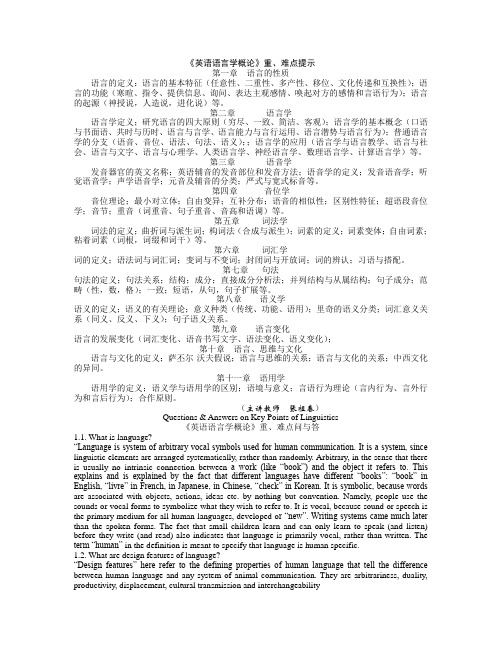
《英语语言学概论》重、难点提示第一章语言的性质语言的定义:语言的基本特征(任意性、二重性、多产性、移位、文化传递和互换性);语言的功能(寒暄、指令、提供信息、询问、表达主观感情、唤起对方的感情和言语行为);语言的起源(神授说,人造说,进化说)等。
第二章语言学语言学定义;研究语言的四大原则(穷尽、一致、简洁、客观);语言学的基本概念(口语与书面语、共时与历时、语言与言学、语言能力与言行运用、语言潜势与语言行为);普通语言学的分支(语音、音位、语法、句法、语义);;语言学的应用(语言学与语言教学、语言与社会、语言与文字、语言与心理学、人类语言学、神经语言学、数理语言学、计算语言学)等。
第三章语音学发音器官的英文名称;英语辅音的发音部位和发音方法;语音学的定义;发音语音学;听觉语音学;声学语音学;元音及辅音的分类;严式与宽式标音等。
第四章音位学音位理论;最小对立体;自由变异;互补分布;语音的相似性;区别性特征;超语段音位学;音节;重音(词重音、句子重音、音高和语调)等。
第五章词法学词法的定义;曲折词与派生词;构词法(合成与派生);词素的定义;词素变体;自由词素;粘着词素(词根,词缀和词干)等。
第六章词汇学词的定义;语法词与词汇词;变词与不变词;封闭词与开放词;词的辨认;习语与搭配。
第七章句法句法的定义;句法关系;结构;成分;直接成分分析法;并列结构与从属结构;句子成分;范畴(性,数,格);一致;短语,从句,句子扩展等。
第八章语义学语义的定义;语义的有关理论;意义种类(传统、功能、语用);里奇的语义分类;词汇意义关系(同义、反义、下义);句子语义关系。
第九章语言变化语言的发展变化(词汇变化、语音书写文字、语法变化、语义变化);第十章语言、思维与文化语言与文化的定义;萨丕尔-沃夫假说;语言与思维的关系;语言与文化的关系;中西文化的异同。
第十一章语用学语用学的定义;语义学与语用学的区别;语境与意义;言语行为理论(言内行为、言外行为和言后行为);合作原则。
专八人文知识材料-语言学
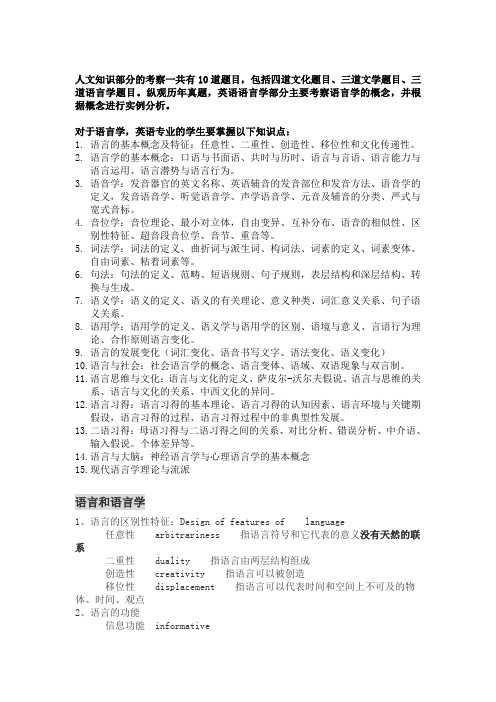
人文知识部分的考察一共有10道题目,包括四道文化题目、三道文学题目、三道语言学题目。
纵观历年真题,英语语言学部分主要考察语言学的概念,并根据概念进行实例分析。
对于语言学,英语专业的学生要掌握以下知识点:1.语言的基本概念及特征:任意性、二重性、创造性、移位性和文化传递性。
2.语言学的基本概念:口语与书面语、共时与历时、语言与言语、语言能力与语言运用、语言潜势与语言行为。
3.语音学:发音器官的英文名称、英语辅音的发音部位和发音方法、语音学的定义,发音语音学、听觉语音学、声学语音学、元音及辅音的分类、严式与宽式音标。
4.音位学:音位理论、最小对立体,自由变异、互补分布、语音的相似性、区别性特征、超音段音位学、音节、重音等。
5.词法学:词法的定义、曲折词与派生词、构词法、词素的定义、词素变体、自由词素、粘着词素等。
6.句法:句法的定义、范畴、短语规则、句子规则,表层结构和深层结构、转换与生成。
7.语义学:语义的定义、语义的有关理论、意义种类、词汇意义关系、句子语义关系。
8.语用学:语用学的定义、语义学与语用学的区别、语境与意义、言语行为理论、合作原则语言变化。
9.语言的发展变化(词汇变化、语音书写文字、语法变化、语义变化)10.语言与社会:社会语言学的概念、语言变体、语域、双语现象与双言制。
11.语言思维与文化:语言与文化的定义、萨皮尔-沃尔夫假说、语言与思维的关系、语言与文化的关系、中西文化的异同。
12.语言习得:语言习得的基本理论、语言习得的认知因素、语言环境与关键期假设,语言习得的过程、语言习得过程中的非典型性发展。
13.二语习得:母语习得与二语习得之间的关系、对比分析、错误分析、中介语、输入假说。
个体差异等。
14.语言与大脑:神经语言学与心理语言学的基本概念15.现代语言学理论与流派语言和语言学1、语言的区别性特征:Design of features of language任意性 arbitrariness 指语言符号和它代表的意义没有天然的联系二重性 duality 指语言由两层结构组成创造性 creativity 指语言可以被创造移位性 displacement 指语言可以代表时间和空间上不可及的物体、时间、观点2、语言的功能信息功能 informative人际功能 interpersonal施为功能 performative感情功能 emotive function寒暄功能 phatic communication娱乐功能 recreational function元语言功能 metalingual function3、语言学主要分支语音学 phonetics 研究语音的产生、传播、接受过程,考查人类语言中的声音音位学 phonology 研究语音和音节结构、分布和序列形态学 morphology 研究词的内部结构和构词规则句法学 syntax 研究句子结构,词、短语组合的规则语义学 semantics 不仅关心字词作为词汇的意义,还有语言中词之上和之下的意义。
英语专业八级语言学总结来源
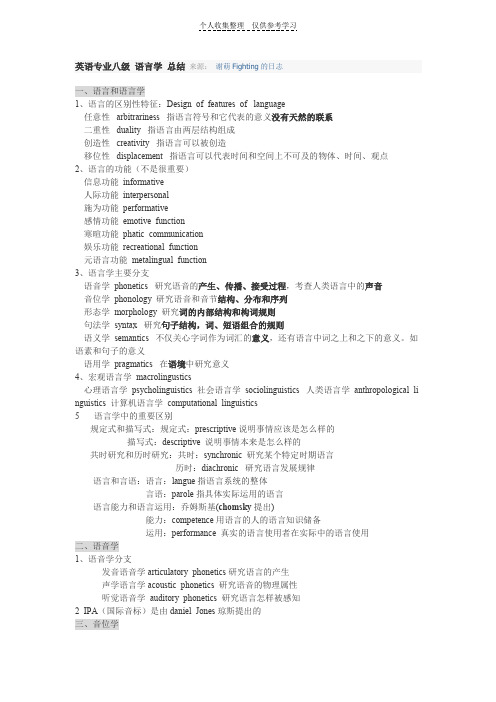
英语专业八级语言学总结来源:谢萌Fighting的日志一、语言和语言学1、语言的区别性特征:Design of features of language任意性arbitrariness 指语言符号和它代表的意义没有天然的联系二重性duality 指语言由两层结构组成创造性creativity 指语言可以被创造移位性displacement 指语言可以代表时间和空间上不可及的物体、时间、观点2、语言的功能(不是很重要)信息功能informative人际功能interpersonal施为功能performative感情功能emotive function寒暄功能phatic communication娱乐功能recreational function元语言功能metalingual function3、语言学主要分支语音学phonetics 研究语音的产生、传播、接受过程,考查人类语言中的声音音位学phonology 研究语音和音节结构、分布和序列形态学morphology 研究词的内部结构和构词规则句法学syntax 研究句子结构,词、短语组合的规则语义学semantics 不仅关心字词作为词汇的意义,还有语言中词之上和之下的意义。
如语素和句子的意义语用学pragmatics 在语境中研究意义4、宏观语言学macrolingustics心理语言学psycholinguistics 社会语言学sociolinguistics 人类语言学anthropological li nguistics 计算机语言学computational linguistics5语言学中的重要区别规定式和描写式:规定式:prescriptive说明事情应该是怎么样的描写式:descriptive 说明事情本来是怎么样的共时研究和历时研究:共时:synchronic 研究某个特定时期语言历时:diachronic 研究语言发展规律语言和言语:语言:langue指语言系统的整体言语:parole指具体实际运用的语言语言能力和语言运用:乔姆斯基(chomsky提出)能力:competence用语言的人的语言知识储备运用:performance 真实的语言使用者在实际中的语言使用二、语音学1、语音学分支发音语音学articulatory phonetics研究语言的产生声学语言学acoustic phonetics 研究语音的物理属性听觉语音学auditory phonetics 研究语言怎样被感知2 IPA(国际音标)是由daniel Jones琼斯提出的三、音位学1、最小对立体minimal pairs2、音位phoneme3 音位变体allophones4 互补分布complementary distribution5 自由变体free variation6 区别特征distinctive features7 超音段特征suprasegmental feature音节syllable 重音stress 语调tone 声调intonation四形态学1 词的构成语素morpheme 自由语素free morpheme 粘着语素bound morphemeRoot 词根词缀affix 词干stem屈折词汇和派生词汇inflectional affix and derivational affix2特有的词汇变化lexical change proper新创词语invention 混拼词blending 缩写词abbreviation首字母缩写词acronym 逆构词汇back-formation例:editor—edit类推构词analogiacal creation 例:work-worked,,slay-slayed外来词borrowing五句法学1 范畴category 数number 性gender 格case 时tense 体aspect一致关系concord 支配关系govenrment2 结构主义学派the structure approach组合关系syntagmatic relation词和词组合在一起聚合关系paradigmatic 具有共同的语法作用的词聚在一起结构和成分construction and constituents :句子不仅是线性结构liner structure还是层级结构hierarchical structure (句子或短语被称为结构体,而构成句子或短语即结构体的称为成分)3直接成分分析法immediate constitutional analysis指把句子分成直接成分-短语,再把这些短语依次切分,得到下一集直接成分,这样层层切分,直到不能再分4向心结构和离心结构endocentric and exocentric constructions 向心:指一个结构中有中心词,例an old man ,中心为man离心:指结构中没有明显的中心词。
专八语言学知识点

第一节语言的本质一、语言的普遍特征(Design Features)1.任意性 Arbitrariness:shu 和Tree都能表示“树”这一概念;同样的声音,各国不同的表达方式2.双层结构Duality:语言由声音结构和意义结构组成(the structure of sounds andmeaning)3.多产性productive:语言可以理解并创造无限数量的新句子,是由双层结构造成的结果(Understand and create unlimited number with sentences)4.移位性 Displacement:可以表达许多不在场的东西,如过去的经历、将来可能发生的事情,或者表达根本不存在的东西等5.文化传播性 Cultural Transmission:语言需要后天在特定文化环境中掌握二、语言的功能(Functions of Language)1. 1. 传达信息功能 Informative:最主要功能The main function2. 2. 人际功能 Interpersonal:人类在社会中建立并维持各自地位的功能establish and maintain their identity3. 3. 行事功能 performative:现实应用——判刑、咒语、为船命名等Judge,naming,and curses4. 4. 表情功能 Emotive:表达强烈情感的语言,如感叹词/句exclamatoryexpressions5. 5. 寒暄功能 Phatic:应酬话phatic language,比如“吃了没?”“天儿真好啊!”等等6. 6. 元语言功能 Metalingual:用语言来谈论、改变语言本身,如book可以指现实中的书也可以用“book这个词来表达作为语言单位的“书”三、语言学的分支1. 核心语言学 Core linguisticl 语音学 Phonetics:关注语音的产生、传播和接受过程,着重考察人类语言中的单音。
- 1、下载文档前请自行甄别文档内容的完整性,平台不提供额外的编辑、内容补充、找答案等附加服务。
- 2、"仅部分预览"的文档,不可在线预览部分如存在完整性等问题,可反馈申请退款(可完整预览的文档不适用该条件!)。
- 3、如文档侵犯您的权益,请联系客服反馈,我们会尽快为您处理(人工客服工作时间:9:00-18:30)。
人文一、语言和语言学1、语言的区别性特征:Design of features of language任意性arbitrariness 指语言符号和它代表的意义没有天然的联系二重性duality 指语言由两层结构组成创造性creativity 指语言可以被创造移位性displacement 指语言可以代表时间和空间上不可及的物体、时间、观点2、语言的功能(不是很重要)信息功能informative人际功能interpersonal施为功能performative感情功能emotive function寒暄功能phatic communication娱乐功能recreational function元语言功能metalingual function3、语言学主要分支语音学phonetics 研究语音的产生、传播、接受过程,考查人类语言中的声音音位学phonology 研究语音和音节结构、分布和序列形态学morphology 研究词的内部结构和构词规则句法学syntax 研究句子结构,词、短语组合的规则语义学semantics 不仅关心字词作为词汇的意义,还有语言中词之上和之下的意义。
如语素和句子的意义语用学pragmatics 在语境中研究意义4、宏观语言学macrolingustics心理语言学psycholinguistics 社会语言学sociolinguistics 人类语言学anthropological linguistics 计算机语言学computational linguistics5语言学中的重要区别规定式和描写式:规定式:prescriptive说明事情应该是怎么样的描写式:descriptive 说明事情本来是怎么样的共时研究和历时研究:共时:synchronic 研究某个特定时期语言历时:diachronic 研究语言发展规律语言和言语:语言:langue指语言系统的整体言语:parole指具体实际运用的语言语言能力和语言运用:乔姆斯基(chomsky提出)能力:competence用语言的人的语言知识储备运用:performance 真实的语言使用者在实际中的语言使用二、语音学1、语音学分支发音语音学articulatory phonetics研究语言的产生声学语言学acoustic phonetics 研究语音的物理属性听觉语音学auditory phonetics 研究语言怎样被感知2 IPA(国际音标)是由daniel Jones琼斯提出的三、音位学1、最小对立体minimal pairs2、音位phoneme3 音位变体allophones4 互补分布complementary distribution5 自由变体free variation6 区别特征distinctive features7 超音段特征suprasegmental feature音节syllable 重音stress 语调tone 声调intonation四形态学1 词的构成语素morpheme 自由语素free morpheme 粘着语素bound morphemeRoot 词根词缀affix 词干stem屈折词汇和派生词汇inflectional affix and derivational affix2特有的词汇变化lexical change proper新创词语invention 混拼词blending 缩写词abbreviation首字母缩写词acronym 逆构词汇back-formation例:editor—edit类推构词analogiacal creation 例:work-worked,,slay-slayed外来词borrowing五句法学1 范畴category 数number 性gender 格case 时tense 体aspect一致关系concord 支配关系govenrment2 结构主义学派the structure approach组合关系syntagmatic relation词和词组合在一起聚合关系paradigmatic 具有共同的语法作用的词聚在一起结构和成分construction and constituents :句子不仅是线性结构liner structure还是层级结构hierarchical structure (句子或短语被称为结构体,而构成句子或短语即结构体的称为成分)3直接成分分析法immediate constitutional analysis指把句子分成直接成分-短语,再把这些短语依次切分,得到下一集直接成分,这样层层切分,直到不能再分4向心结构和离心结构endocentric and exocentric constructions向心:指一个结构中有中心词,例an old man ,中心为man离心:指结构中没有明显的中心词。
例:on the shelf5生成学派the generative approach深层结构deep structure指机构关系中的潜在层面underlying level表层结构surface structure指结构形成的最后结果阶段final stage6功能学派the functional approach主位与述位theme and rheme主位:谈话中已知的信息,说话者从它谈起known,述位:与说话者内容有关的内容what the speaker states about7交际力communicative and dynamism简称CD指句子成分对交际发展所作的贡献的程度六、语义学1 利奇的意义七分法Leech and his 7 types of meaning概念意义conceptual meaning 字面意义内涵意义connotative meaning 实际交往过程中所指的事物社会意义情感意义affective meaning反射意义reflective meaning 由一个词语联想起来的另外一种意义搭配意义collocative meaning主位意义thematic meaning 通过调整信息的顺序和强调内容所表达的意义2指称论referential theory指将词的意义和他所指的食物联系起来的意义理论3语义三角semantic triangle 奥格登和理查兹提出Symbol或form指语言要素(如词和语素),the linguistic elements能指thought指概念concept所指reference指经验世界中的物体the object in the word of experience涵义sense语言形式的意义4主要涵义关系○同义关系synonymy地域同义词dialectal synonymy风格同义词stylistic synonyms感情同义词synonymys that differ in connotation意义相同,但内涵不同,有褒有贬○反义关系antonymy等级反义关系gradable antonymy 例cool-warm ;hot-cold互补反义关系complementary antonymy,肯定A就否定B,否定B 就肯定A,例dea d-alive反向反义关系converse antonymy .reversal of a relationship between 2 en tities.例husband-wife; teacher-student○上下义关系hyponymy 意义包含关系。
例:花-水仙、玫瑰、百合补充:同音同形异义关系homonymy一词多义polysemy七、语用学1 言语行为理论speech act theory奥斯汀提出John Langshaw Austin认为人在说话的同时也在进行一定的行为动作○施为句和叙事句performative and constative施为句:实施某种行为。
叙事句:描述说话人在说话时所作的动作。
○行事行为理论a theory of the illocutionary act言内行为:locutionnary act表述字面意思言外行为:illoutionary act 因为言语本身的习惯力量随之产生的其他一些行为言后行为:perlocutionnary act 话语在听者身上产生的效果2会话含义理论the theory of conversational implicature格赖斯提出Herbert Paul Grice○合作原则:说话人和听话人为达一定的交际目的,都有一种默契,一种都遵循的原则○四个准则four categories of maxims数量、质量、关系、方式(manner)准则3后格赖斯时期的发展○关联理论:relevance theory:交际应被看做一种表明自身说话意图的行为every act of ostensive(直接表明的) communication communicates the presumption of its ow n optimal relevance○数量关系和关系原则the Q-and R-principles由霍恩Laurence Horn 提出八现代语言学理论和流派1 索绪尔Saussure瑞士语言学家,―现代语言学之父‖或者―使语言学科走向现代的大师‖2 布拉格学派Prague School贡献:共时语言学研究,从―功能‖角度看待语言,强调语言的系统性,把语言看做一种功能突出贡献:语音学说,及其划分语音学和音位学突出:Trubetzkoy特鲁别茨柯依:提出语音学属于言语,音位学属于语言,提出音位概念4伦敦学派the Lundon School:系统语言学和功能语言学创始人:弗斯Firth.人物:弗斯受马林诺夫斯基影响。
韩礼德为新弗斯派领袖三人都强调语言环境和语言系统的重要性韩礼德和系统功能语法:由系统语法和功能语法构成。
把实际使用的语言现象作为研究对象5美国结构主义American Structuralism共时语言学分支,由博厄斯提出F.Bos.○撒皮尔-沃尔夫假说Sapir-Whorf Hypothesis语言相对论-语言决定论○布隆菲尔德Bloomfield《语言论》-20世纪被大西洋两岸同时奉为科学的方法论典范和语言学领域的杰出代表。
描述语言学的代表人物6 转换生成语法transformational–generative grammar乔姆斯基提出Chomsky.认为语言是某种天赋,语言习得机制Language Acquisition device1. A Tale of Two Cities was written by Charles Dickens.2. Phonology: The study of speech sounds in language or a language with reference to their distribution and patterning and to tacit rules governing pronunciation. 音位学; 在语言或一门语言中,对有关其分类和模式以及为大家所默认的发音规则的研究音韵学, 音系学3. Syntax: The study of the rules whereby words or other elements of sentence str ucture are combined to form grammatical sentences. 句法,研究词或其它句子成分如何联合起来形成合乎语法的句子规则的学科4. Semantics: The study or science of meaning in language forms.语义学,以语言形式表示意思的研究或科学5. acronym : 首字母组合词,首字母缩略词,比如,NATO, UNESCO, BASIC,它们可以连拼,但VOA是Initialism。
